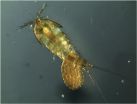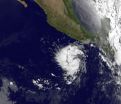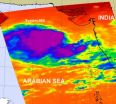(Press-News.org) Although adding gravel to a river to replace lost sediments won't likely cool the whole river channel, it can create cool water refuges that protect fish from thermal pollution, according to a U.S. Forest Service Pacific Northwest Research Station study.
The research—featured in the June 2011 issue of Science Findings, a monthly publication of the station—is among the first to explore the interplay between sub-surface water flow and temperature in large rivers and is helping to guide river restoration strategies in the Pacific Northwest.
In the study, which began in 2006, station research hydrologist Gordon Grant and Oregon State University colleagues Barbara Burkholder and Roy Haggerty examined the effect of subsurface water flow through riverbed sediment—a process known as "hyporheic flow"—on daily minimum and maximum water temperatures. The focus of their study was Oregon's Clackamas River, which, at the time, was undergoing intensive restoration planning efforts led by Portland General Electric (PGE) as part of the relicensing process for the river's hydroelectric system. The addition of gravel to the large river as part of these efforts—aimed primarily at reversing changes in river channel morphology that have resulted from sediment transport being interrupted by the dams—allowed the researchers to explore whether doing so had any measurable effect on reducing "thermal pollution," or unusually high water temperatures caused by human activities like dam operation, logging, and wastewater treatment.
"Previous work suggested that water emerging from gravel bars might actually be cooler than the surrounding water," said Grant.
The research team hypothesized that the continual cycling of subsurface water through the riverbed—during which cool nighttime water would travel through the gravel bar, exiting and mixing with the stream during the warmer daytime—would have a "buffering" effect that would keep the river's daily peak temperatures down, but not necessarily change the river's overall mean temperature. To explore their hypothesis, they mapped the locations of gravel bars along a 15-mile stretch of the river and documented the temperature of water cycling into and out of each of them.
They found 52 temperature differences within the stretch of the Clackamas, with temperatures at these locations from 1 to 4 degrees cooler than the main channel. The researchers were then able to link the cooler areas with specific gravel bar features and with specific times and locations within the Clackamas to create models that depicted the subsurface flow patterns—ultimately revealing that a very small percentage of the river's water actually passed through the gravel bars, making any overall effect on the mean temperature minute.
"Results showed a hundredth of a degree of temperature change through a single bar," said Grant. "Not much."
This finding suggests that gravel augmentation alone is not likely to have a significant temperature-mediating effect in large rivers. However, the work demonstrated that gravel augmentation may provide local habitat benefits to fish and small invertebrates by creating cool areas within rivers where they can seek refuge during hot weather.
###
To read the June 2011 issue of Science Findings online, visit http://www.treesearch.fs.fed.us/pubs/37952.
The PNW Research Station is headquartered in Portland, Oregon. It has 11 laboratories and centers located in Alaska, Oregon, and Washington and about 425 employees.
'Thermal pollution' in rivers not fully mediated by gravel augmentation
Cool patches created by adding gravel, however, can serve as important refuges for fish
2011-06-09
ELSE PRESS RELEASES FROM THIS DATE:
Eating a high-fat diet may rapidly injure brain cells that control body weight
2011-06-09
Obesity among people who eat a high-fat diet may involve injury to neurons, or nerve cells, in a key part of the brain that controls body weight, according to the authors of a new animal study. The results will be presented Tuesday at The Endocrine Society's 93rd Annual Meeting in Boston.
"The possibility that brain injury may be a consequence of the overconsumption of a typical American diet offers a new explanation for why sustained weight loss is so difficult for most obese individuals to achieve," said presenting author Joshua Thaler, MD, PhD, a faculty member with ...
Can evolution outpace climate change?
2011-06-09
Animals and plants may not be able to evolve their way out of the threat posed by climate change, according to a UC Davis study of a tiny seashore animal. The work was published today (June 8) in the journal Proceedings of the Royal Society B.
The tide pool copepod Tigriopus californicus is found from Alaska to Baja California — but in a unique lab study, the animals showed little ability to evolve heat tolerance.
"This is a question a lot of scientists have been talking about," said study co-author Eric Sanford, an associate professor of evolution and ecology at UC ...
UAB first in US with cell-processing workstation
2011-06-09
BIRMINGHAM, Ala. – The University of Alabama at Birmingham has taken a significant step toward making sophisticated cell therapy a part of patient care with its acquisition of the first cell-processing workstation (CPWS) from SANYO North America Corporation (SANYO) in the United States.
Richard Marchase, Ph.D., vice president for Research and Economic Development at UAB, says "UAB has a rich history of breaking ground in the cell-therapy arena. We are thrilled that we were able to be the first in the United States to use SANYO's CPWS. This will add to our world-class ...
A double-satellite NASA-style view of the first tropical storm in eastern Pacific: Adrian
2011-06-09
The first tropical depression in the Eastern Pacific Ocean is now the first tropical storm, and two satellites are providing NASA insights into its thunderstorms, rainfall, and intensity. NASA satellite data on newly born Tropical Storm Adrian shows high cloud tops and moderate rainfall, indications that the storm is getting stronger, triggering a tropical storm watch in Mexico.
Tropical Depression 1E is the first tropical depression of 2011 and formed in the eastern Pacific Ocean early on June 7. By the morning of June 8 it had strengthened into Tropical Storm Adrian, ...
NASA imagery sees a reawakening of system 98A in the Arabian Sea
2011-06-09
System 98A has been bringing rains, gusty winds and churning up the surf along the Arabian Seacoast of west-central India for days, and NASA satellite imagery confirms that it is getting organized now that it has moved into open waters.
NASA's Atmospheric Infrared Sounder (AIRS) instrument onboard NASA's Aqua satellite captured an image on June 8 at 08:47 UTC (4:47 a.m. EDT) of the hundreds of thunderstorms that make up the low pressure area called System 98A. The low pressure area has now moved to the west-southwest and away from Mumbai, India. In fact, today it is located ...
Stable temperatures boost biodiversity in tropical mountains
2011-06-09
Durham, NC — We often think of rainforests and coral reefs as hotspots for biodiversity, but mountains are treasure troves for species too —especially in the tropics, scientists say. But what drives montane biodiversity? The diversity of plants and animals in tropical mountain ranges may have something to do with the stable seasonal temperatures found in the tropics relative to higher latitudes, says a new study by scientists working at the US National Evolutionary Synthesis Center.
The study, based on nearly 200 species of bats, birds, frogs, lizards and snakes, also ...
The diving bell and the water spider: How spiders breathe under water
2011-06-09
Gazing into the depths of a pond, it's hard to miss the insects that whirl and zip beneath the surface. However, only one species of spider has joined them: the diving bell spider, Argyroneta aquatica. 'It is an iconic animal; I had read about the spider as a small boy in popular literature about ponds,' says Roger Seymour from the University of Adelaide. According to Seymour, each spider constructs a net of silk in vegetation beneath the surface and fills it with air carried down on its abdomen. The spiders spend their entire lives submerged and even lay their eggs in ...
Study suggests police officer wrongfully convicted for missing the 'obvious'
2011-06-09
CHAMPAIGN, Ill. — In a new study, researchers tested the claims of a Boston police officer who said he ran past a brutal police beating without seeing it. After re-creating some of the conditions of the original incident and testing the perceptions of college students who ran past a staged fight, the researchers found the officer's story plausible.
The study appears in the peer-reviewed open access journal i-Perception.
Psychology professors Christopher Chabris (Union College) and Daniel Simons (University of Illinois) often explore the limits of visual attention – ...
'Decade of vaccines' has potential to save lives, but challenges ahead
2011-06-09
Bethesda, MD – Vaccinating children around the world against infectious diseases has saved the lives of millions over the past several decades. Now new opportunities exist to overcome remaining challenges—and save another 6.4 million lives over the current decade, according articles in the June 2011 edition of Health Affairs. The issue was produced under the journal's grant from the Bill & Melinda Gates Foundation.
Last year, the Gates Foundation committed an additional $10 billion over the current decade to make life-saving vaccines available to millions of children. ...
Pioneering hospital pay-for-performance program falls short of its goals
2011-06-09
Massachusetts' innovative use of "pay-for-performance" bonuses to try to reduce racial and ethnic disparities in the case of Medicaid patients has turned up no evidence of the problem at any of the state's 66 acute-care hospitals, according to a new study that raises questions about the effectiveness of the state's novel approach.
While the study, published in the June edition of Health Affairs (June 9, 2011), found that racial and ethnic inequities for disadvantaged patients may well exist, it also determined that the hospital "pay-for-performance" approach – typically ...
LAST 30 PRESS RELEASES:
Scientists boost cell "powerhouses" to burn more calories
Automatic label checking: The missing step in making reliable medical AI
Low daily alcohol intake linked to 50% heightened mouth cancer risk in India
American Meteorological Society announces Rick Spinrad as 2026 President-Elect
Biomass-based carbon capture spotlighted in newly released global climate webinar recording
Illuminating invisible nano pollutants: advanced bioimaging tracks the full journey of emerging nanoscale contaminants in living systems
How does age affect recovery from spinal cord injury?
Novel AI tool offers prognosis for patients with head and neck cancer
Fathers’ microplastic exposure tied to their children’s metabolic problems
Research validates laboratory model for studying high-grade serous ovarian cancer
SIR 2026 delivers transformative breakthroughs in minimally invasive medicine to improve patient care
Stem Cell Reports most downloaded papers of 2025 highlight the breadth and impact of stem cell research
Oxford-led study estimates NHS spends around 3% of its primary and secondary care budget on the health impacts of heat and cold in England
A researcher’s long quest leads to a smart composite breakthrough
Urban wild bees act as “microbial sensors” of city health.
New study finds where you live affects recovery after a hip fracture
Forecasting the impact of fully automated vehicle adoption on US road traffic injuries
Alcohol-related hospitalizations from 2016 to 2022
Semaglutide and hospitalizations in patients with obesity and established cardiovascular disease
Researchers ‘listen in’ to embryo-mother interactions during implantation using a culture system replicating the womb lining
How changing your diet could help save the world
How to make AI truly scalable and reliable for real-time traffic assignment?
Beyond fragmented markets: A new framework for efficient and stable ride-pooling
Can shape priors make road perception more reliable for autonomous driving?
AI tracks nearly 100 years of aging research, revealing key trends and gaps
Innovative techniques enable Italy’s first imaging of individual trapped atoms
KIER successfully develops Korea-made “calibration thermoelectric module” for measuring thermoelectric device performance
Diversifying US Midwest farming for stability and resilience
Emphasizing immigrants’ deservingness shifts attitudes
Japanese eels, climate change, and river temperature
[Press-News.org] 'Thermal pollution' in rivers not fully mediated by gravel augmentationCool patches created by adding gravel, however, can serve as important refuges for fish



